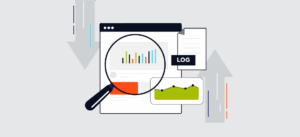AI log analysis probably doesn’t sound like the most exciting use of artificial intelligence. But if you’re an IT pro trying to deal with today’s huge volumes of log data, it might just be one of the most useful applications of AI out there. To understand why, let’s explore exactly what AI log analysis is, how it addresses the core challenges of traditional log analysis, and what the business benefits it offers. Then we’ll illustrate by diving into how AI log analysis can help you with one particularly critical and complex task: IT migrations.
What is AI log analysis?
AI log analysis refers to the use of artificial intelligence (AI) to automatically collate, analyze, categorize and extract actionable information from the log data generated by various IT systems. Logs provide a detailed, time-stamped record of system events and errors, which are critical for troubleshooting application and user issues, uncovering potential threats, and optimizing system health and performance. However, as IT environments increase in size and complexity, the volume and variety of log data soars. Traditional log analysis methods simply cannot scale effectively, leaving organizations vulnerable in a wide range of important areas, from threat detection and response to vital initiatives like IT migration projects. Moreover, they can cause issues with information overload.
AI log analysis offers a powerful strategy for addressing these critical challenges. By leveraging technologies such as machine learning (ML), natural language processing (NLP) and anomaly detection algorithms, AI can process vast amounts of log data in real time to pinpoint issues and even offer actionable guidance for effective response.
What are the limitations of traditional log analysis?
Log analysis has been around for as long as computers have existed. But as IT ecosystems have grown in size and complexity, traditional methods for understanding log data have become less effective. The primary reasons for this are:
- High data complexity — Log data is notoriously complex and cryptic. Moreover, logs are generated by diverse sources, including servers, network devices and applications, and mastering the language of one type of log is no guarantee of fluency in another. As a result, human analysts can struggle to process the variety of logs across today’s increasingly complex IT environments.
- Growing data volumes — Log analysis often requires sifting through thousands, if not millions, of lines of log data. With traditional tools, this process is very time-consuming. Indeed, the volume of log data generated in larger and more complex IT environments can overwhelm even enterprise-size IT teams.
- Lack of context — Log entries are typically disjointed bits of information. IT administrators often struggle to piece together the context in which a particular certain event occurred within a given log, let alone correlate log data from different sources to gain the visibility they need across the IT ecosystem.
- Human errors and inconsistencies — Manual log analysis is highly prone to human error. For instance, administrators can overlook critical data points, miss connections between events, misinterpret information, or fail to detect patterns indicative of suspicious behavior or emerging issues. Plus, manual log analysis often requires multiple individuals, frequently from different teams. The resulting fragmented insights can make it difficult to understand the bigger picture and quickly design effective responses.
- Scalability issues — As IT environments grow, the number of logs being generated can skyrocket. Traditional log analysis methods often cannot scale effectively to handle these massive datasets.
How does AI log analysis work?
AI log analysis is designed to quickly analyze huge volumes of disparate log data and provide actionable insights. The process typically includes the following steps:
1. Data collection, preprocessing and parsing
Raw log data is collected from various sources across the IT infrastructure, such as servers, databases, applications and network devices. Examples include error logs, transaction logs and performance logs. The data is preprocessed to remove noise, normalize data formats, and extract key details like error codes, timestamps, user IDs and IP addresses.
2. Data correlation and anomaly detection
AI tools often rely on machine learning (ML) models that have been trained on historical log data to establish a baseline of normal behavior. Any deviation from this baseline, such as an anomalous spike in traffic or unusual user activity, is flagged as an anomaly. This analysis often requires correlating data from multiple different logs, which can be extremely difficult to do manually. For instance, an error in an application log could be linked to a specific network issue or server failure recorded in a separate log.
3. Root cause analysis and predictive analytics
To pinpoint the root cause of issues uncovered in the log data, AI tools often leverage internal databases and external sources like knowledgebase articles, vendor reports and CVE records. Advanced AI tools can also provide predictive analytics. For example, based on trends in system performance, AI can predict when a hardware component might fail or when an application might experience increased load.
4. Reporting of insights and recommendations
The final step is to provide insight to the IT team. More basic forms of output can include raw log data converted into a more readable format and summaries of findings. However, advanced log analysis tools can offer actionable steps for resolving emerging issues, such as recommending resource scaling to avoid business disruptions.
What are the benefits of AI log analysis?
Organizations can realize a wealth of benefits from using AI in log analysis, including:
- Faster threat detection — AI tools can quickly spot unusual activity that could indicate a security issue, even when the clues are scattered across multiple logs. Moreover, AI can proactively detect vulnerabilities and emerging issues before they become pressing threats.
- More effective incident response — AI can automatically alert IT teams to threats and other issues, and the best tools even provide actionable steps for fast and effective resolution.
- Stronger security — Log analysis solutions powered by AI can promptly detect signs of potential security threats, such as unusual changes that could signal privilege escalation by an attacker or data modification attempts indicative of ransomware. What’s more, AI models continuously learn from new data to improve their detection capabilities over time.
- Cost savings — AI can dramatically reduce the need for expensive IT experts to spend time on manual log analysis, easing resource requirements. And by quickly detecting emerging threats and offering targeted guidance for effective response, it helps prevent costly downtime and business disruptions.
- Improved operational efficiency — By streamlining the log analysis process, AI frees up IT teams to focus on optimizing system performance, planning for future infrastructure needs and other critical tasks.
How can AI log analysis help with IT migration projects?
One key area where AI log analysis can deliver enormous benefit is IT migrations. Migrations are a delicate business, akin to trying to change out various car parts — while the car is still in motion. In the case of Active Directory migration, it’s like trying to swap in a whole new engine! It’s essential to get the job done right, but timelines are often tight and unyielding.
The problem is that even with the best planning, no migration project proceeds exactly as designed. Instead, you run into issues, from small hiccups to huge roadblocks, that you need to troubleshoot. Why didn’t this password sync properly? Why didn’t this mail message or attachment come over properly? Resolving the problem and getting the migration process back on track requires analyzing the logs. But as we have seen, trying to manually parse thousands of lines of cryptic log data can be exceedingly slow and tedious, and then determining how to resolve the problem can require poring through multiple knowledgebase articles and other sources.
For AD and device migrations, troubleshooting can be even more challenging. One factor is the sheer complexity of the project. Over time, Active Directory tends to sprawl wildly, so there’s a lot to keep track of, from identities and security groups to trust relationships between domains and forests. In addition, the IT pros assigned to the project may never have performed a migration before, and Active Directory expertise is in increasingly short supply.
AI log analysis can quickly identify common problems, such as lack of necessary permissions or corrupted items in the source environment. While these issues might seem simple and straightforward, tracking them down manually takes time and expertise that lean IT teams often lack. AI log analysis mitigates these challenges by quickly providing a clear explanation of what the problem is and clear recommendations for fixing it.
AI log analysis can also help diagnose more esoteric issues. For example, if the account being used to perform a migration job has some — but not all — the permissions it needs to access resources, sorting out the exact problem can take a long time. By referencing extensive catalogs of migration issues and leveraging machine learning, AI tools can quickly identify the root problem quickly and offer guidance for resolving it effectively.
Additional ways that AI will help with migrations in the near future
Log analysis is just the beginning of how AI will be making migrations faster and more secure. Other areas where AI will prove valuable include:
- Infrastructure analysis and planning — AI will be useful in identifying problem areas in the environment that might cause issues with migration, such as outdated software, slow domain controller (DC) replication times and poor infrastructure health. While many of these issues are fairly straightforward, with manual methods, identifying and rectifying them takes significant time, effort and expertise. By making it easier to perform a thorough and accurate analysis, AI tools will reduce the risk of failed migration jobs.
- Migration scheduling — Organizations frequently struggle to develop an effective migration schedule. For instance, they often have a large number of SharePoint sites that are used by various teams for different purposes. Which should be moved first? How should that content migration be coordinated with user account migration? By analyzing site structure, memberships and activity data, an AI tool could quickly discover that 80% of the data for a given site is being generated by the HR team and therefore recommend migrating that site in concert with the HR user accounts.
Conclusion
AI log analysis is becoming increasingly essential in today’s complex IT environments. Unlike traditional log analysis tools that leave IT struggling with to process huge volumes of cryptic logs, AI can quickly digest log records, surface the most critical insights and provide actionable recommendations to simplify a wide range of tasks, including vulnerability management, threat detection and incident response, and Active Directory migration and modernization.



